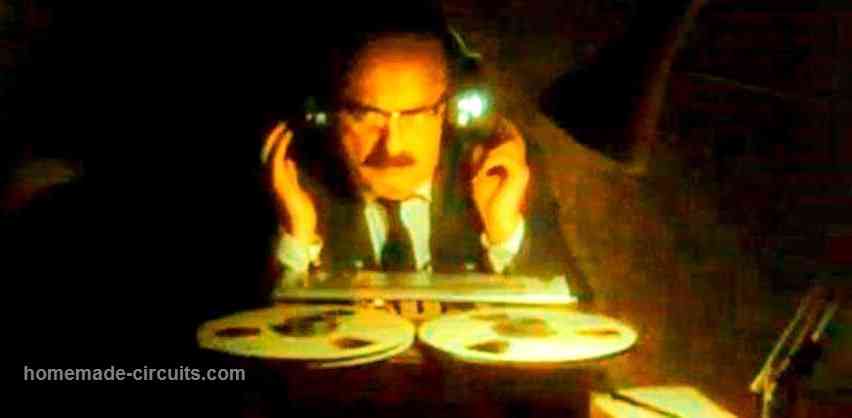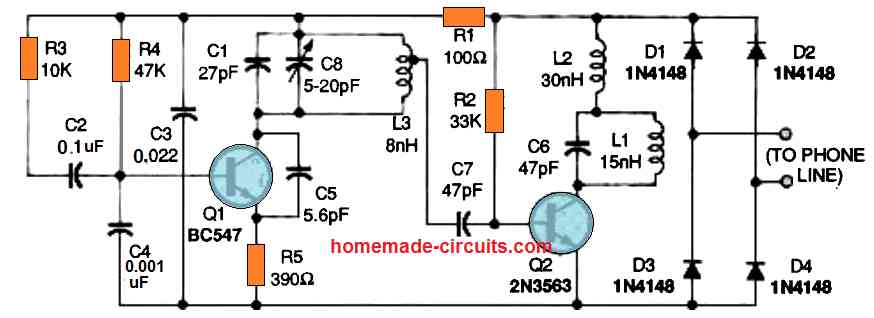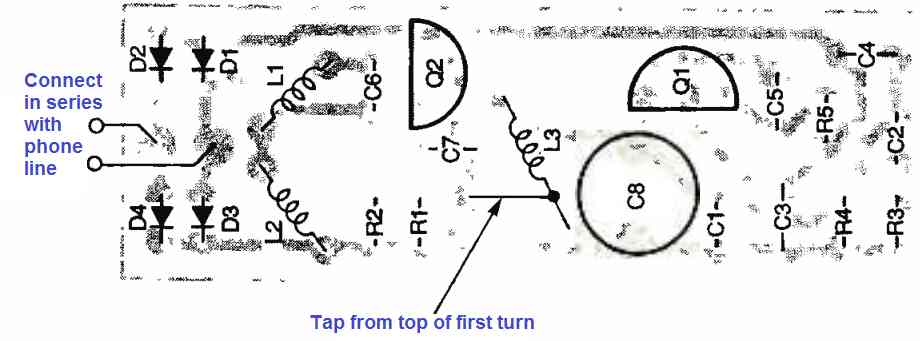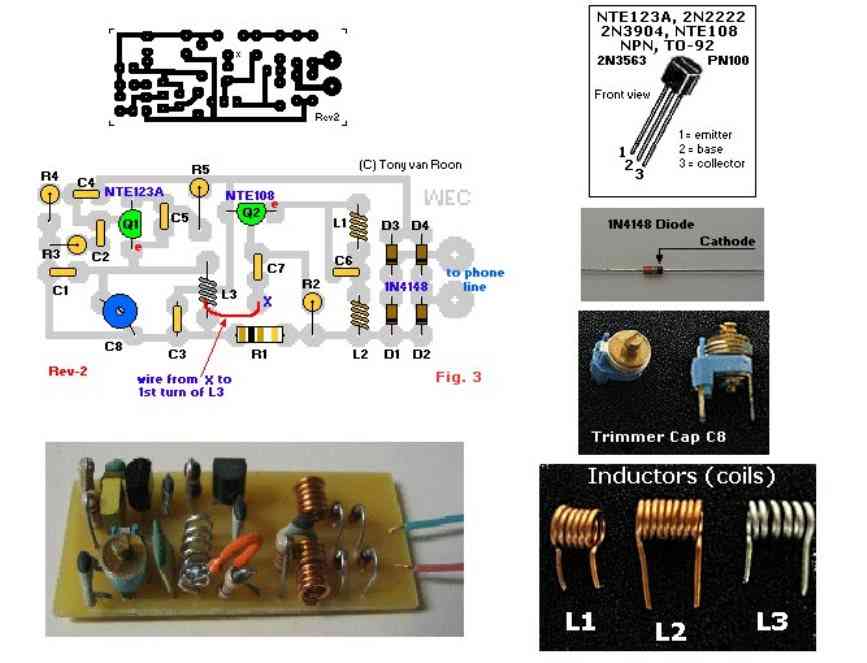In this post I will explain how a landline telephone can be rigged up wirelessly with a small transmitter circuit, enabling easy tapping of the telephone, by transmitting the conversations to a distant FM radio appropriately set up for the listening.

Circuit Description
The circuit diagram for the Telephone Transmitter can be witnessed in the figure below. That design is supposed to be connected in series with one of the telephone lines ow telephone input wires.

Power to the circuit is extracted through a full-wave bridge rectified which is taken from the phone line itself via the diodes D1----D4. Transistor Q1, capacitors C1 and C8, along with the inductor L3 work like an FM oscillator operating with a frequency of approximately 93 MHz.
Adjustable trimmer capacitor C8 enables the oscillator frequency to be tweaked through 90 MHz and 95 MHz. To be able to stretch the tuning range up to the 98 and 105 MHz range, C1 could be substituted with a 10 pF capacitor.
The voice frequency from the phone line is connected by means of resistor R3 and capacitor C2 on the base of transistor Q1, which subsequently modulates the audio with the oscillator frequency. Next, transistor Q3, inductor L1, and capacitor C6 are configured to work like a power amplifier.
The signal extracted from the inductor L3 tapping is supplied to the transistor Q2 base which then enables the transmission of the modulated FM signal via the collector pin of the Q2 transistor. Inductor L2 is configured like a radio-frequency shunt which decouples the power supply DC from the amplified audio signal.
How to Build
The telephone transmitter circuit is very straightforward and could be built over a veroboard, although the compact PCB design shown below looks more preferable and is recommended.

While assembling the parts on the PCB, you may refer to the component overlay diagram as illustrated in the following figure.

Get started by fitting and soldering the resistors and diode. You may find the PCB layout very compact and therefore you may have to assemble most of the horizontal parts in vertical mode. Next, it is time to install and solder the inductors.
Constructing and Fitting the Inductors
Inductors L1 and L2 can be wound by using 6 and 8 turns of super enameled copper wire, respectively.
If you decide to wind the coils at home, you may use around 22 SWG super enameled copper wire and a 1/8 inch drill bit as the measure for the winding former.
The enamel coating at the coil wire ends which need to be soldered, must be thoroughly scraped, and cleaned until they are shiny and without any layer of the enamel, so that they can be perfectly soldered on the PCB.
Coil L3 can be built using 6 turns of tinned copper wire over a 1/8 inch diameter former. After winding, make sure to pull and stretch the coil turns about 1 mm apart from each other and also ensure none of the turns are touching with each other.
Next, you must extract a tapping by scratching off the enamel coating from the top of the first turn of L3, and then solder a wire on it, which can be connected on the specified PCB point.
Once the coil assembly is over, start soldering the fixed capacitors along with the variable trimmer. After this you can go for the transistors and solder on their respective slots.
This concludes the assembly of the phone transmitter circuit.
Before you hook up the transmitter to the phone lines make sure to examine the PCB and the part assembly for any possible errors, and rectify them appropriately if you find any.
The transmitting range of the circuit is over 100 feet. However, it is easily possible to extend this range significantly by soldering a flexible wire antenna (approximately 150 cm in length) to the collector of Q2.
How to Tune and Set up the Transmitter
Connect the Transmitter inputs in series with one of the telephone lines through any suitable method you are comfortable with. Switch on a FM radio positioned somewhere near, and tune it to a relatively silent spot on the FM band, which can be anywhere in the region of 90 and 95 MHz.
Now, pick up the telephone handset; this must immediately allow you to hear the dial tone loud and clear on the selected FM radio band. If that doesn't happen, you may try tweaking the trimmer capacitor C8 until the dial tone is heard distinctly on the radio.
In the process, first fine-tune C8 to get the most suitable reception on the FM radio, next tweak the radio knob for improving the outcome even further. In case you find it difficult to get a null spot on the specified band, remember that it is possible to expand the tuning range up to the 98 to 105 MHz mark, simply using a 10 pF capacitor in place of the C1 capacitor.
More information regarding the telephone transmitter was found from the website electronics-diy.com/index.php, which can be witnessed in the following image.

Great circuit! I have had tried similar circuit some 3 decades ago and transmitted within 3 km range. I would rather like to pick up my naughty granddaughter’s mobile phone which is harassing me these days. Any idea, please let me know on my email.
Thank you.
Muni Raj
Thank you…That sounds interesting, however unfortunately this circuit cannot be fixed on mobile phones, since it is too big to be inserted into a mobile, nevertheless an SMD version of the same can perhaps be tried which possibly might just fit in some corner inside a cellphone.